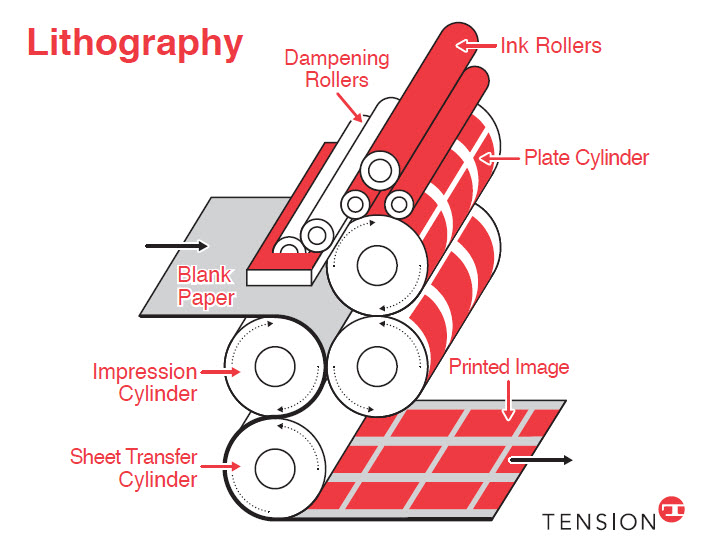litho printing vs Digital Printing: What to Understand
litho printing vs Digital Printing: What to Understand
Blog Article
A Comprehensive Overview to Understanding Litho Printing Techniques
The world of litho printing, a method stemming from the late 18th century, is a remarkable mix of background, scientific research, advancement and art. Remain with us as we trip into the exciting realm of litho printing.
The Historical Advancement of Litho Printing
The historical trajectory of litho printing, a critical advancement in the realm of interaction, is a captivating tale of human ingenuity. Birthed in the late 18th century by Alois Senefelder, this method was originally an economical technique of publishing staged works. Lithography, derived from the Greek words for 'rock' and 'to compose', used a smooth rock surface to move pictures onto paper. The procedure evolved with the introduction of the rotary press, which significantly increased performance (litho printing). In the 20th century, the innovation of offset lithography transformed the sector, permitting automation of top quality prints. Each stage of litho printing's evolution showcases humankind's unrelenting pursuit of efficiency and high quality in visual interaction.
Translating the Scientific Research Behind Litho Printing Inks
Relocating onward in the expedition of litho printing strategies, the focus now shifts to the scientific research behind litho printing inks. The structure of these inks, their drying out process, and shade mixing strategies develop the foundation of this intricate art kind. Recognizing these aspects is essential to mastering the craft and accomplishing the preferred print outcomes.
Structure of Litho Inks
In lithographic printing, the fundamental duty of litho inks can not be overstated. The structure of litho inks differs relying on its objective, but usually, they contain two main components - lorries and pigments. Pigments, the color-providing aspects, are finely ground bits suspended in the car, a liquid that lugs the pigment onto the printing surface. The vehicle is a complicated combination of resins, solvents, and oils, which influence the ink's drying out time, bond, and gloss. Additionally, different ingredients are present to improve particular residential properties like circulation, drying out, and resistance to ecological results. Each component plays a critical component in the final print's top quality, making the specific solution of litho inks an elaborate science.
Ink Drying Refine
From the composition of litho inks, focus turns to the interesting procedure of ink drying. The drying out procedure is essential, as it affects the final print's high quality and durability. Two primary approaches are used in litho printing: oxidative drying and absorption. Oxidative drying includes the ink responding with oxygen airborne to form a hard, completely dry movie. This technique gives a durable coating, yet can be slower compared to absorption. Absorption, on the various other hand, entails the ink leaking into the paper fibers, which is a quicker procedure but can result in less dynamic shades. The selection between these techniques depends on factors such as print rate requirements, the paper kind made use of, and the preferred surface.
Shade Mixing Methods
While the drying process plays a key role in litho printing, the scientific research of shade blending strategies holds equal relevance. The science behind litho printing inks likewise takes right into account the transparency of the ink, which influences exactly how shades overlay and mix.
The Art and Design Aspects in Litho Printing
Litho printing breathes life into art and style through its special components. Litho printing fits a range of colors, enabling artists to create vivid and vibrant prints. This mix of accuracy and flexibility makes litho printing a recommended selection for numerous musicians and designers.
Modern Applications of Litho Printing Techniques
Litho printing methods have located considerable usage in the modern-day commercial market. Its influence and value continue to grow with the arrival of new innovations and innovations in the field. This section will certainly check out these modern applications and the transformative that site duty they play in the printing market.
Commercial Litho Printing Utilizes
Litho printing continues to be a critical component of the business market. High-volume printing jobs, such as the production of books, papers, and product packaging, count on litho printing for its ability to supply premium picture quality and price efficiency. Litho printing also gives a broad shade range, exceptional to that of electronic printing.
Technologies in Litho Printing
Pressing the boundaries of typical techniques, modern-day developments have actually sustained a host of advancements in litho printing. One famous advancement is electronic litho printing, which combines the virtues of digital modern technology with litho's top quality outcome. These find out here developments emphasize the enduring relevance of litho printing in the modern-day world.
Discovering the Process of Litho Printing: Step by Step

Obstacles and Solutions in Contemporary Litho Printing

Regardless of the you can try this out accuracy and practice that litho printing proudly upholds, it is not without its set of contemporary obstacles. The most common problems consist of the high initial configuration price, problem in printing variable data, and environmental issues as a result of chemical use. Solutions are arising as modern technology evolves. Digital litho printing enables economical brief runs and very easy personalization, dealing with the issue of variable information. Environmentally-friendly inks and safer plate-making procedures alleviate ecological problems. Additionally, developments in automation have lowered labor costs, additionally democratizing the lithography procedure. Hence, while there are difficulties, the litho printing industry is proactively adapting to satisfy them head-on, ensuring its significance in the future.
Conclusion
In final thought, litho printing, with its rich background and clinical intricacies, holds a significant location in the print market. The future of litho printing hinges on its ability to adapt to these transforming needs, verifying its enduring value in an advancing market.

Report this page